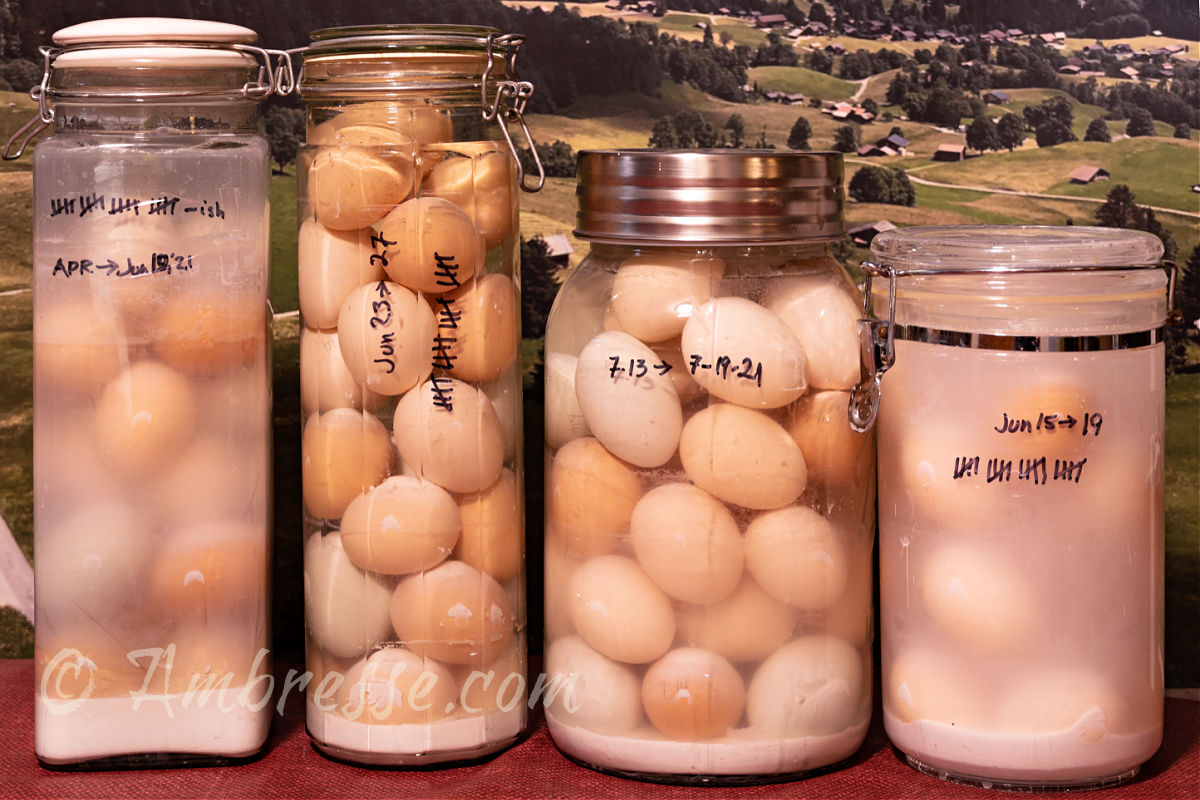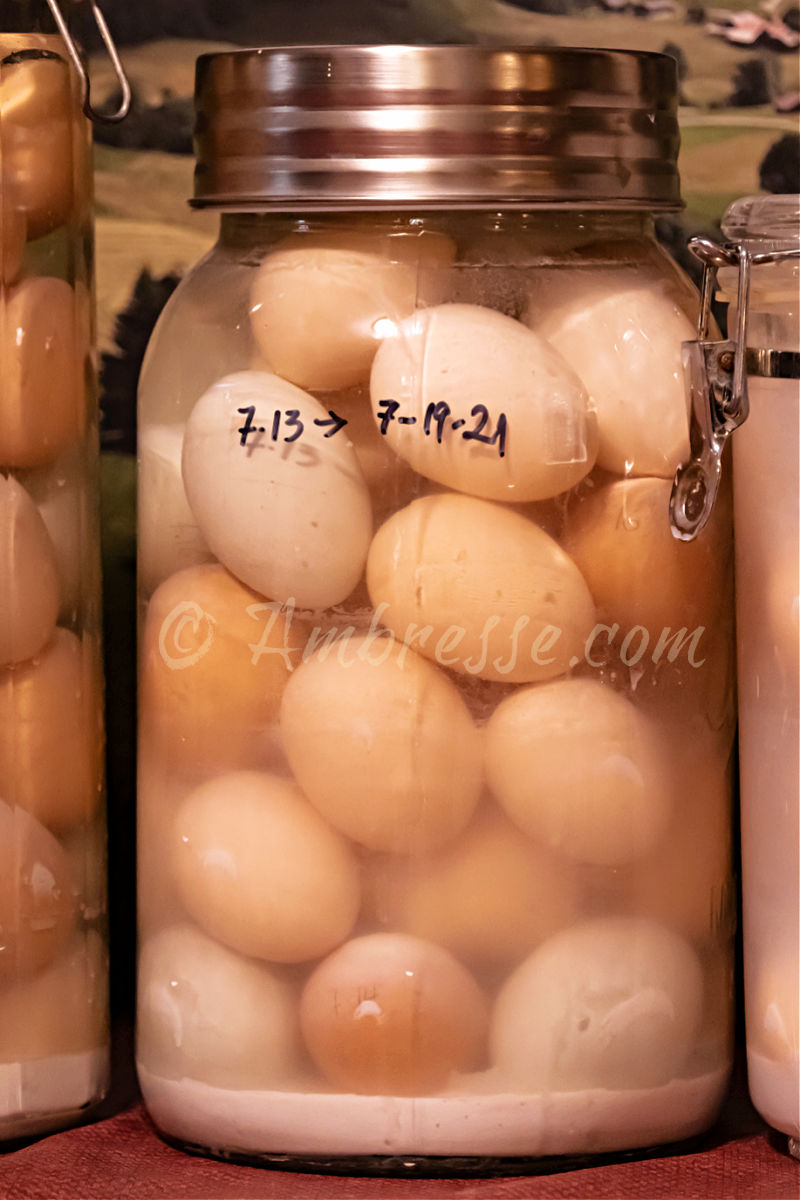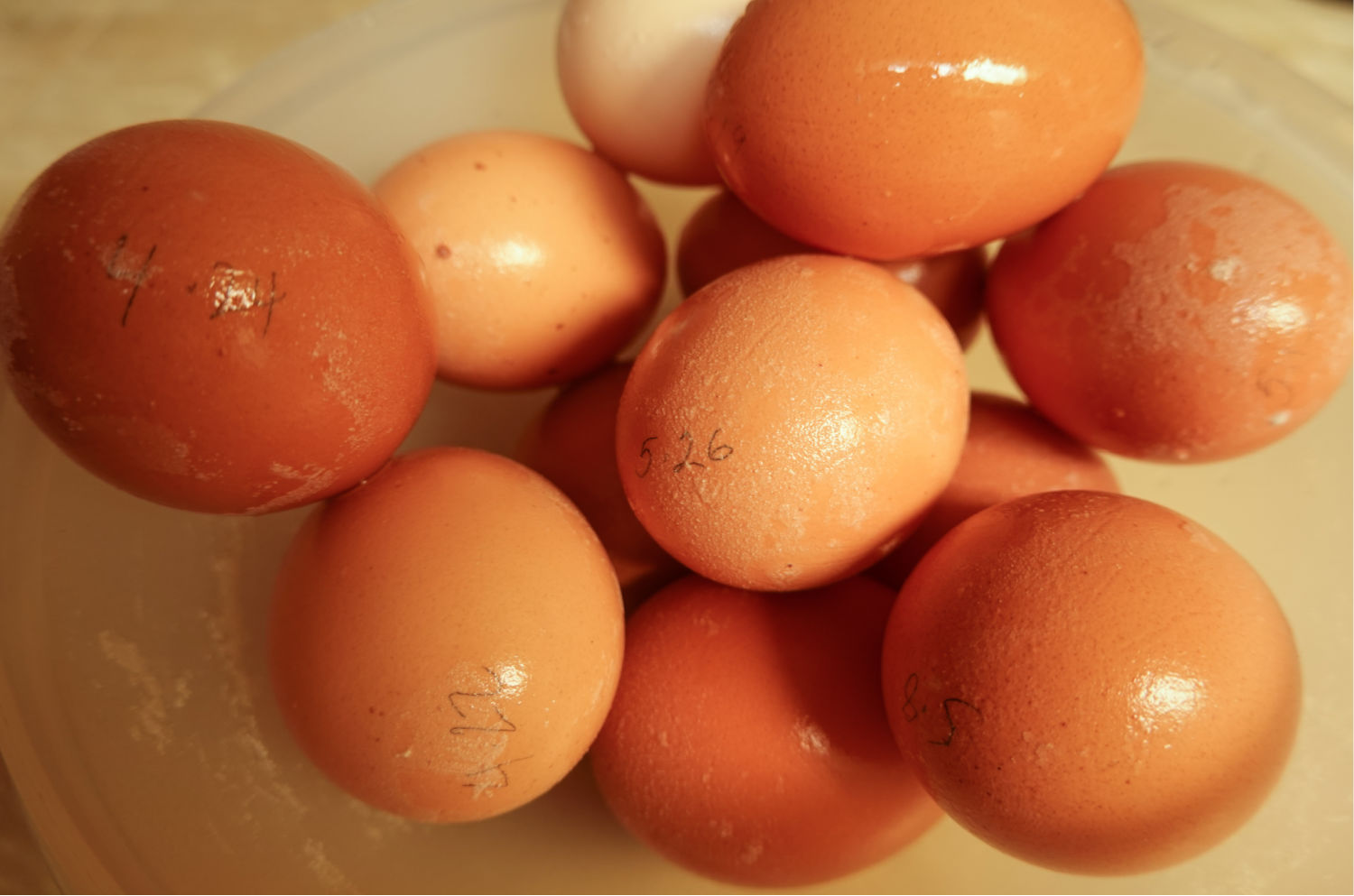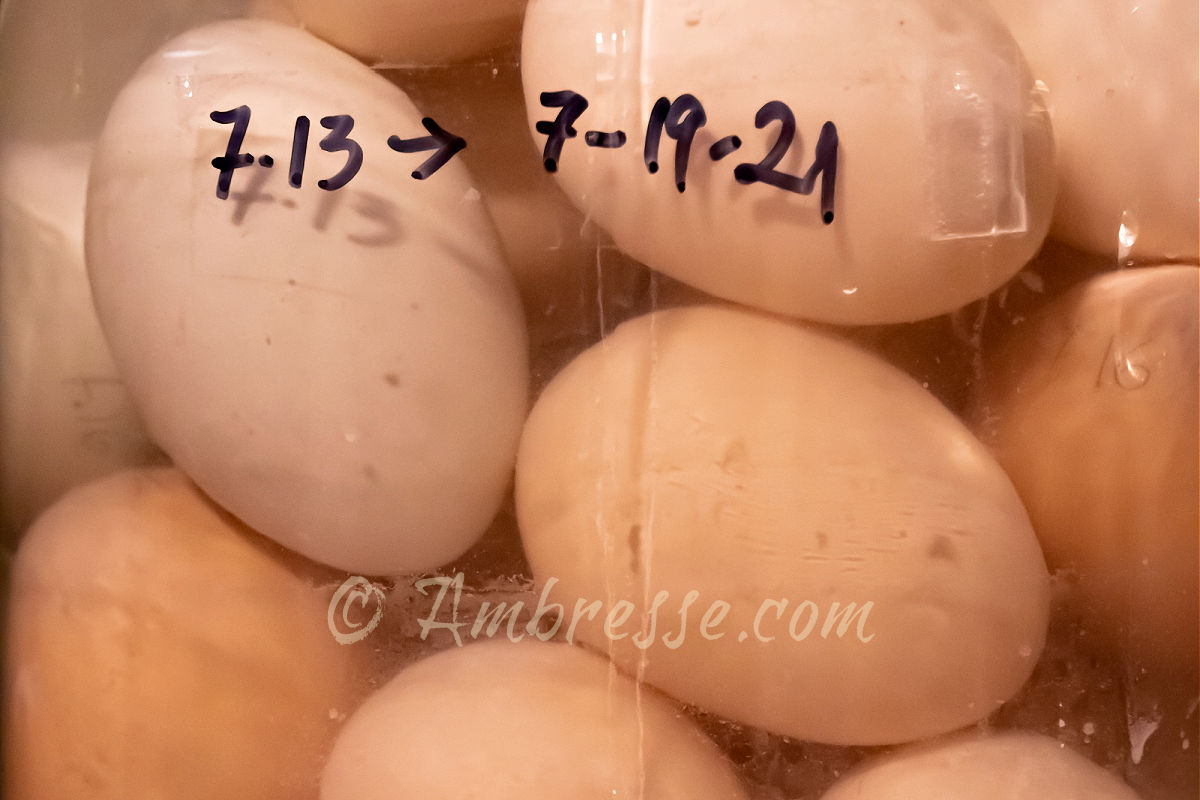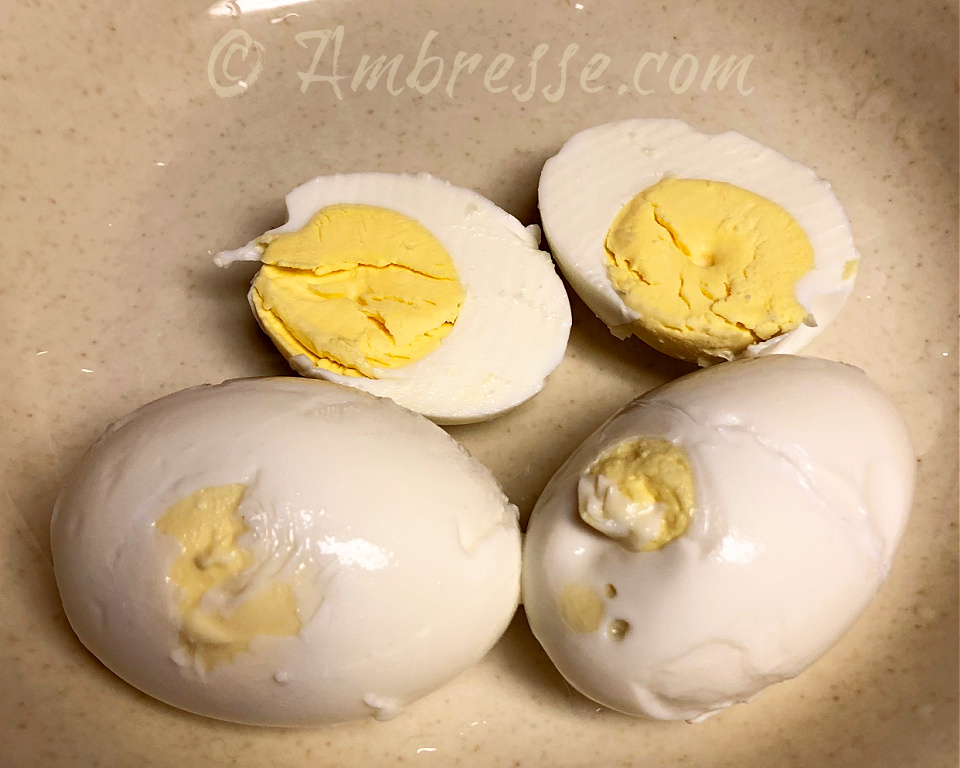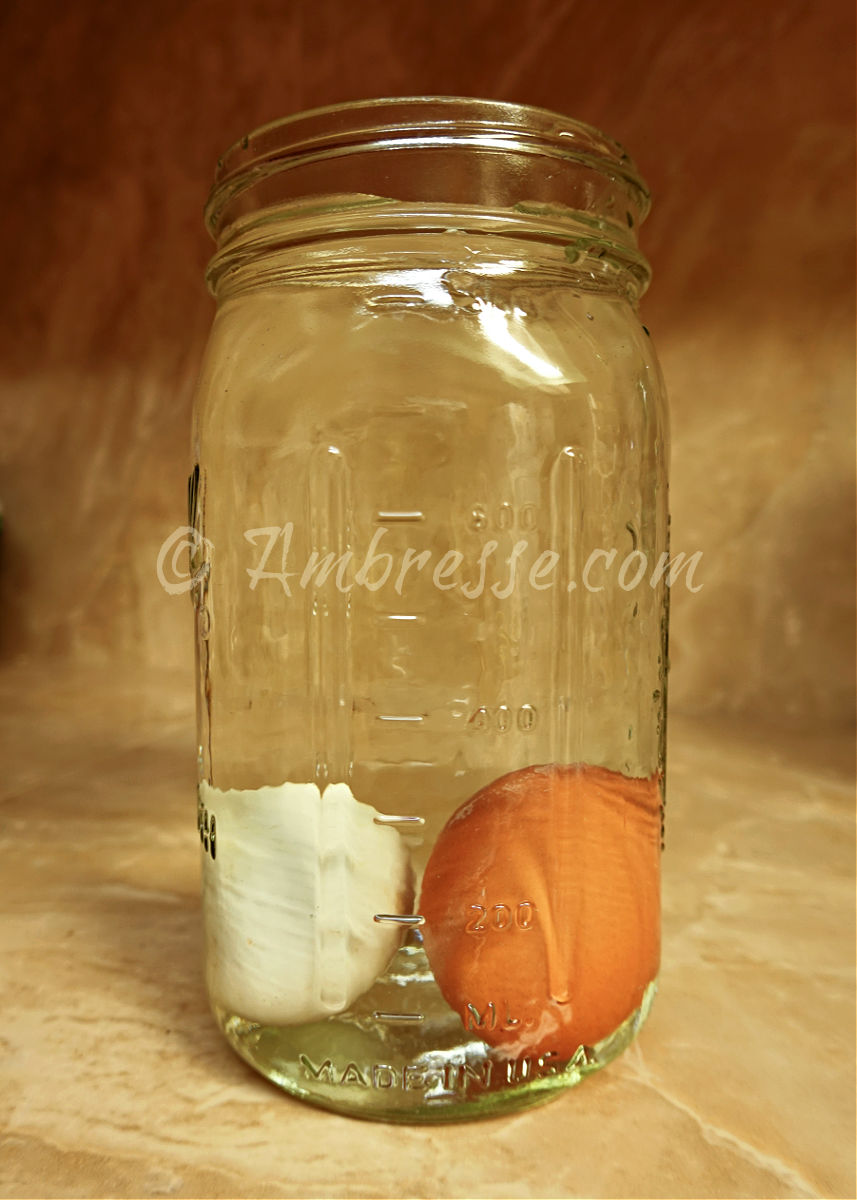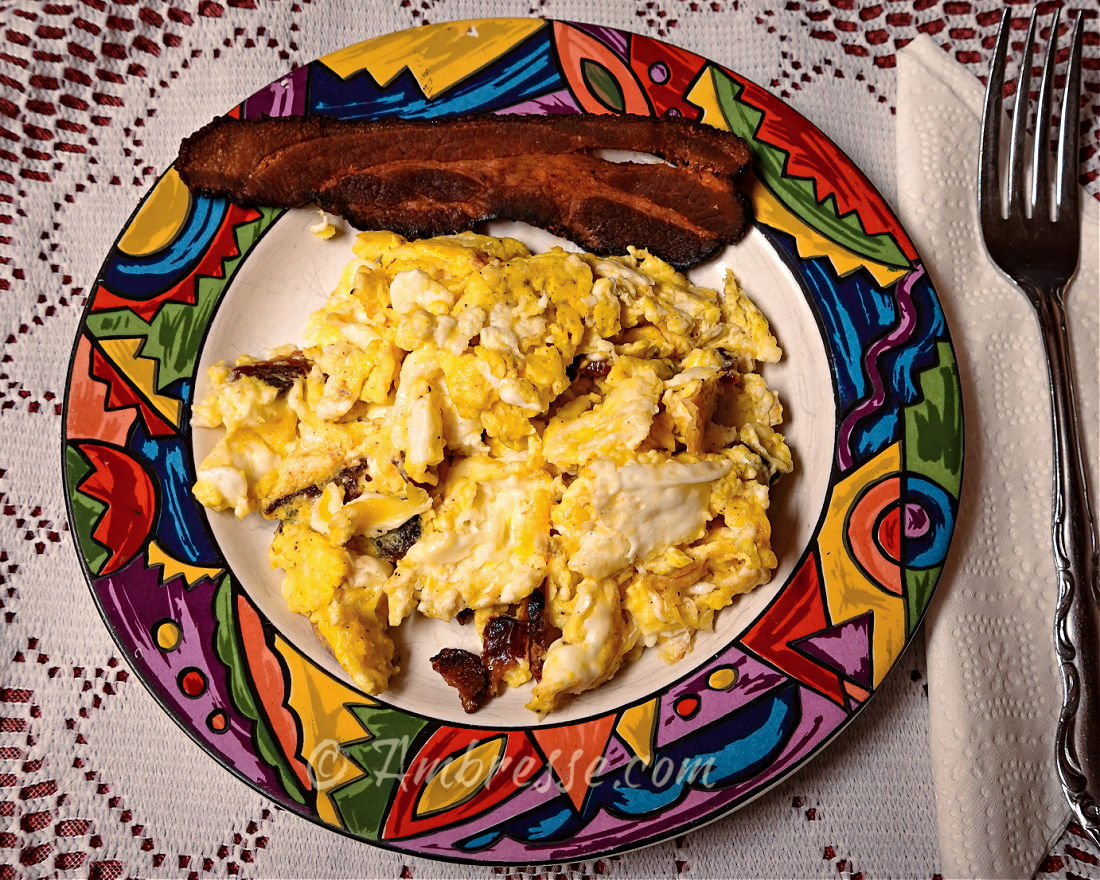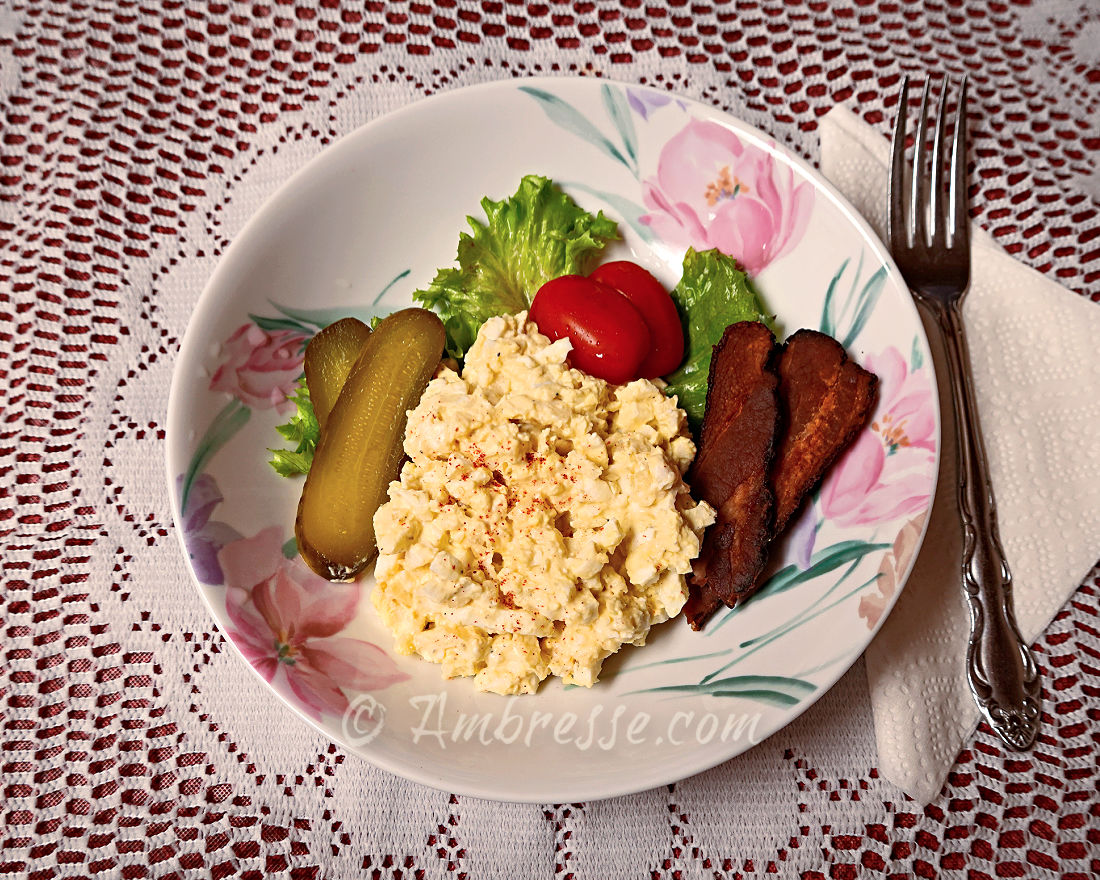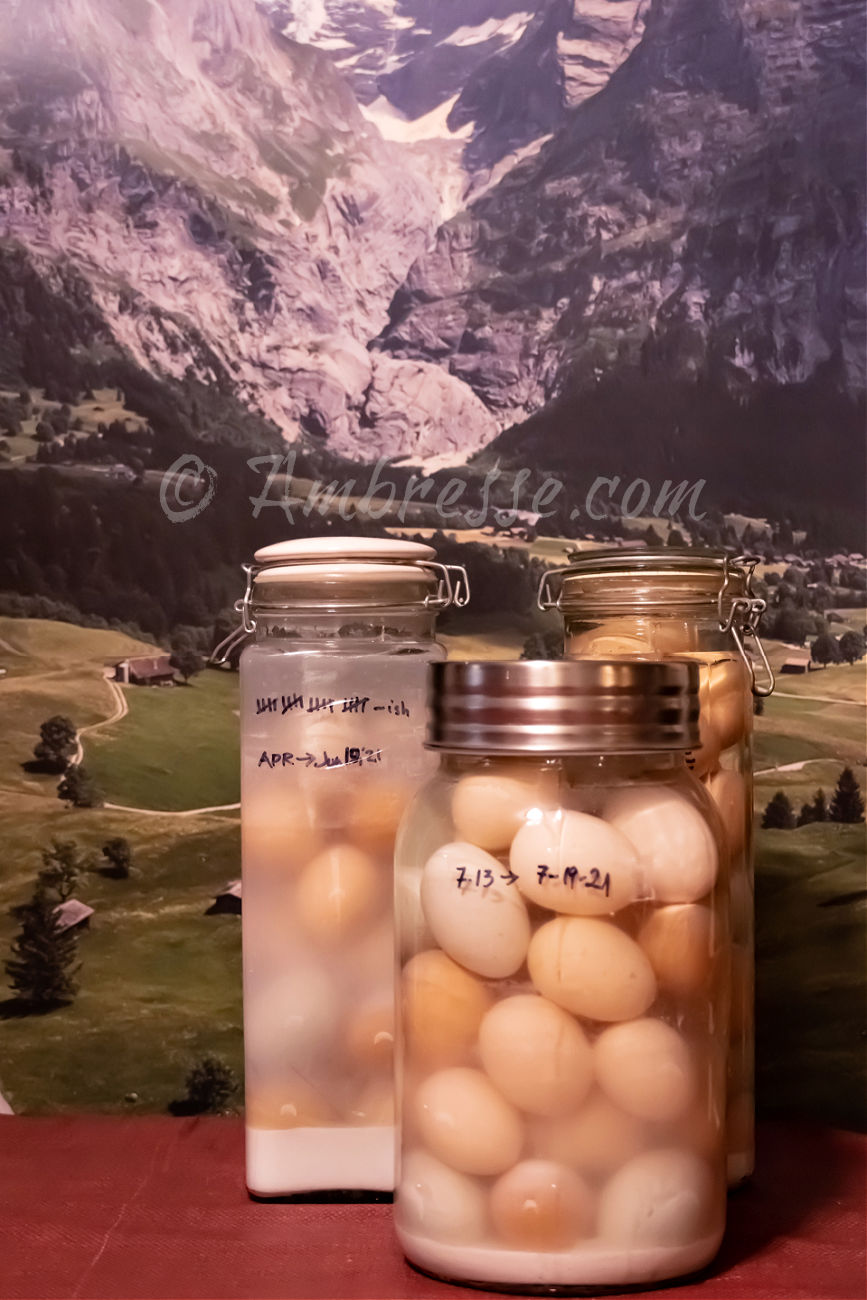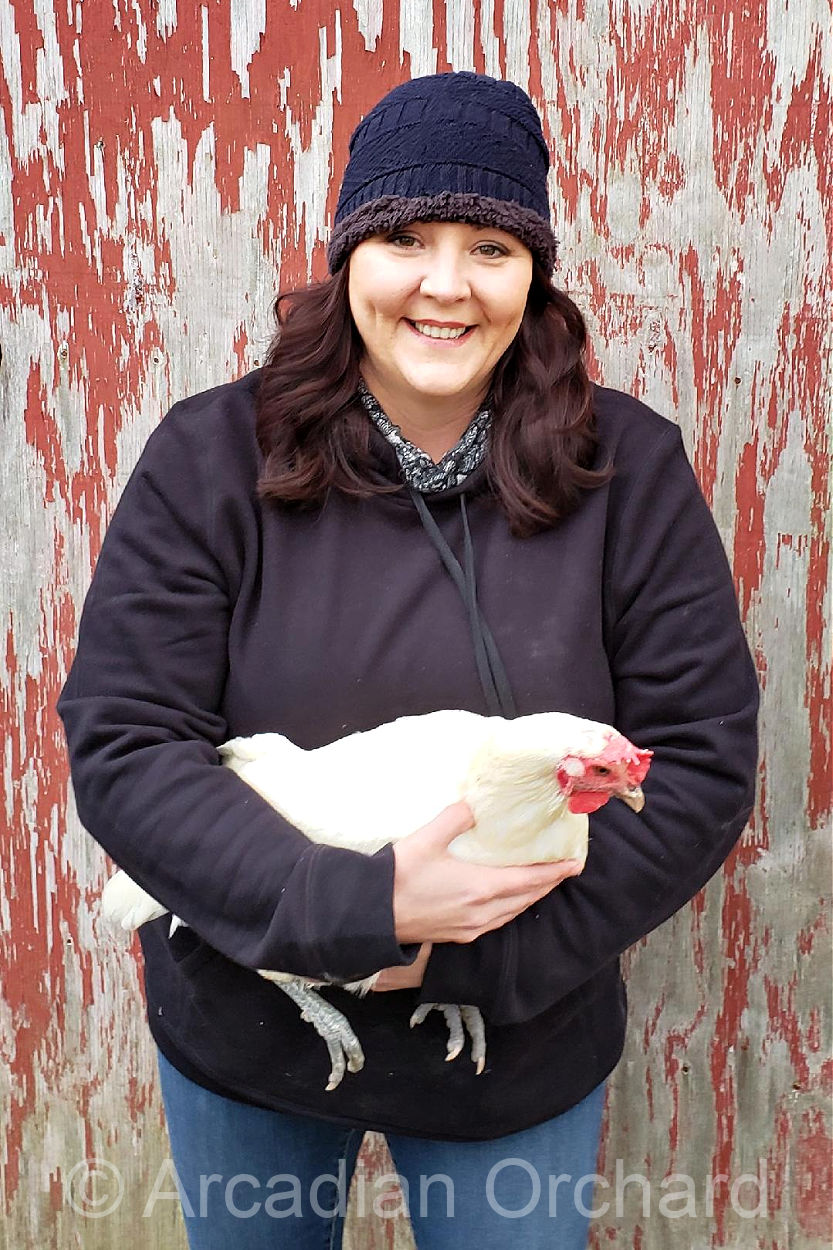Waterglassing Eggs
Waterglassing Eggs: Enjoy eggs year round! Here is how to water glass your extra eggs through the spring, summer, and fall so you'll have nearly fresh eggs to eat all year long.
One of the main reasons to keep chickens is the abundance of ultra farm-fresh, brightly yolked eggs. There is just one little glitch to this terrific plan of keeping chickens for their eggs: They go "on strike" for a month or so every year while they molt, leaving you with almost no eggs for up to two months of the year.
Pictured at Right: Four large glass jars of water glassed eggs. Most of these are American Bresse eggs. The photo was taken in January and the eggs are still very fresh after 6-8 months.
Hens typically and happily lay eggs in late winter, spring, summer, and into the fall months. As the daylight hours shorten and the temperatures drop, egg production also drops significantly. For around 4-6 weeks, hens lay an egg only occasionally as they molt and then rebuild their bodies in preparation for another year of regular egg-laying.
This means that the chicken keeper has an abundance of eggs for much of the year, and then ALMOST ZERO eggs for a month or so during winter.
Preparing in advance by water glassing the excess eggs is a perfect solution to the time of lack, because waterglassing eggs keeps them fresh for up to a year or more.
How to Waterglass Eggs
Egg preservation using waterglassing can be done by using either of two methods:
- Use a hydrated lime solution, also referred to as slake lime, pickling lime, or calcium hydroxide
- Use a sodium silicate solution, also known as water glass, which is how the term, waterglassing eggs, came about.
Using Hydrated Lime for Waterglassing Eggs
My favorite method of waterglassing eggs is to use a solution of hydrated lime. Here's how to water glass eggs using hydrated lime:
Make Your Waterglass Solution:
- Make your waterglassing solution by mixing filtered water with powdered hydrated lime. Hydrated lime can typically be purchased at hardware stores, a big box store such as Home Depot, or at a local sand, gravel or tile supplier, which is where I purchased mine.
Hydrated lime is inexpensive. A large, 50-pound bag set me back USD$16.00. It'll last me a VERY long time! - Mix the hydrated lime with water using this ratio: 1 ounce hydrated lime to 1 quart (or litre) water.
- Stir well. The solution will be milky white, and the particulates will settle to the bottom after a while.
Gather Your Clean Glass (or Food-Grade Plastic) Covered Containers:
- An ideal size container is one-half or one gallon. It will hold upwards of 40 eggs. But you can use whatever will hold and cover the eggs you wish to waterglass.
- (If an egg happens to go bad in the solution, it will float to the top of the water and poison the entire bucket, both with germs and with a terrible taste. By waterglassing in multiple smaller containers, you can limit loss should one of the containers need to be discarded.)
- Fill the container only two-thirds full with hydrated lime solution. This is to allow room in the container for adding eggs.
Gather Your Eggs:
- Eggs must be clean and UN-washed. This is because the bloom needs to remain on the eggs to continue to protect them from the environment, and the bacterial load in the waterglass container should be kept to a minimum.
- Eggs should be very fresh. Collect them daily, and waterglass them right away, or within 24 to 36 hours. The fresher they are, the longer they will last when waterglassed.
Place Your Eggs in the Waterglass Solution:
- When waterglassing many eggs at a time, fill the waterglassing container with eggs to a point that allows the waterglassing solution to completely cover the eggs by an inch (2.5 cm) or so.
- When waterglassing a few eggs at a time, fill the waterglassing container with the solution, and add eggs daily on the day they are laid. I like to mark each egg with the date it was laid.
Cover the glass jar or container:
- The liquid will evaporate away if the container is not covered, and the eggs will spoil if not fully covered in the waterglassing solution. It is smart to check your waterglassing jars from time to time to ensure the eggs remain covered. Add a bit of water if necessary.
Months Later: Removing Eggs from Waterglass Solution
When you're ready to remove and use the waterglassed eggs:
- Remove the waterglassed eggs and place them in the sink in a large bowl filled with clean water.
- Discard any eggs that are already cracked.
- Discard any eggs that don't sink to the bottom of the water.
- Rinse the eggs well in order to remove any remaining hydrated lime from the outside of the shells
- Set them on a towel on the kitchen counter and allow them to air-dry.
- Place the dry eggs into a clean egg carton. Label the carton with the fact that the eggs are raw and already waterglassed, if needed.
- Refrigerate.

Egg Preservation Using Water Glass
An alternate method of waterglassing eggs is using sodium silicate, also known as water glass. This is actually the original method and is how waterglassing eggs got its name.
Sodium silicate is also called "liquid glass," because it desiccates into very hard sheets of glass. Sodium silicate can preserve eggs for remarkably long periods of time, and by the same principles as does hydrated lime. The very fine sodium silicate particulates in waterglass seal all the pores in the egg's shell, greatly slowing down degradation and spoilage for up to one year or possibly longer.
How to Waterglass eggs using Sodium Silicate
Sodium silicate is a viscous solution which is used for many purposes beyond just waterglassing eggs. The Science Notes website provides an overview on sodium silicate and its uses, and also gives instructions for making your own waterglass solution. It also includes a how-to video, which we have embedded below:
Yes, you can make your own sodium silicate or water glass. BUT: You can also purchase it, which greatly simplifies the process of waterglassing eggs.
Obtain sodium silicate in powder form or in liquid form. Whatever form you obtain, you will mix it with purified or filtered water in a prescribed ratio, specified below with the product links. This will become your water glass solution.
Follow the directions for waterglassing with hydrated lime above, as the process is identical, though the solution is different.
NOTE: Eggs must be fresh, completely clean, and UNWASHED.
Obtain Prepared Sodium Silicate
There are many brands and types of sodium silicate available for purchase. These brands were reasonably priced and will work well for waterglassing eggs.
Humco Sodium Silicate Solution.
Ratio is 1 part Humco Sodium Silicate solution to 3 parts water. Use the entire 30 ounces to make 3.75 quarts of sodium silicate solution for waterglassing eggs.
Eastchem Sodium Silicate powder.
Ratio is one part Eastchem Sodium Silicate powder to 9 parts water.
Mix the whole packet with 1.25 gallons of purified water. Stir until fully dissolved.
In case you were interested, here is a fascinating video outlining the many uses of waterglass:

Drawbacks to Waterglassed Eggs
Amazingly, there are very few drawbacks to waterglassing eggs! The drawbacks are mostly cosmetic, because in my experience, they taste great!
- They may peel with difficulty, because the sealed pores do not allow for the egg white to separate well from the egg membrane.
- The yolks will have drifted to the edge of the egg white, and might possibly have adhered to the membrane. This is mostly cosmetic because they still taste great, but it is perhaps the greatest detraction, to looks, anyway.
- The egg whites become runny, and spread out in a frying pan. Doesn't mean they're bad, however!
- The shells may crack when boiled. This is because with sealed pores, the pressure difference between the inside and the outside of the egg cannot adjust fast enough. When you add heat, the shell cracks. This is cosmetic.
Pictured below are hard boiled waterglassed eggs that are 7 months old. The yolks had drifted to the edges and the shells had cracked during boiling. They were also difficult to peel, as though they were fresh. (Makes for some rather ugly - though tasty - devilled eggs!)

Questions and Answers about Waterglassing Eggs
What is Waterglass for Eggs?
What is Waterglass for Eggs?
This refers to either of the two solutions that can be used for longer-term preservation of eggs. Technically, "water glass" is a sodium silicate solution, but the term is used interchangeably for both sodium silicate and hydrated lime, since the two methods of waterglassing eggs do exactly the same thing - they seal the egg shell pores, resulting in the ability to store eggs long term.
Are water glassing eggs safe?
Is water glassing eggs safe?
Yes, waterglassing eggs is a generally safe and reliable method for storing eggs. They are safe to eat even when they have been waterglassed for months or longer.
But if you are in doubt, do the egg float test! The YourHobbyFarm.com website has a very good picture of how the egg float test works.
Place the eggs in a glass of water. if they sink to the bottom, they are safe. If they float, they are spoiled; throw them out.
Pictured here: the egg float test. One egg has been water glassed, and the other had been laid within the last few hours. Both passed the egg float test with flying colors - by resting flatly at the bottom of the jar.
Can you water glass eggs in a plastic container?
Can you water glass eggs in a plastic container?
Yes, waterglassing eggs in a plastic container is safe when the container is food-grade, such as House Naturals. Many sizes and brands of food-grade containers are available. They are marked "food grade" or BPE-Free. A 1-gallon pail is a great size for waterglassing eggs.
Is pickling lime the same as hydrated lime?
Is pickling lime the same as hydrated lime?
Yes. Pickling lime is:
- Calcium hydroxide
- Hydrated lime
- Slake lime
- Builder's lime
All these terms are interchangeable.
Is storing eggs in lime water safe?
Is storing eggs in lime water safe?
Yes, it is safe. Follow the directions on this page, do not try to store the eggs for too many months or years, and test the eggs with the egg float water test when you remove them from the waterglassing solution, especially if they have been stored longer than 6 months. Note that on this page, we use the term, hydrated lime instead of lime water. It's the same thing.
How do you use water glassed eggs?
How do you use water glassed eggs?
You can use them in any fashion you like, if it doesn't require a beautiful presentation of the egg itself. For example, they do great in baking or in recipes calling for eggs as an ingredient.
In the same vein, you can scramble them, or make egg salad for sandwiches.
If you insist, go ahead and hard-boil them. Or prepare a plate of devilled eggs! They'll be delicious, but not at all pretty. (If you don't care and your friends don't care, I certainly won't care either!)
Other Ways to Preserve Eggs
In addition to waterglassing eggs, here are a few other ways to preserve your surplus eggs:
- Store clean, fresh, dry eggs in sawdust or shavings. Keeps them very dry. Should preserve eggs for roughly 3 months.
- Oiling, for example in mineral oil. Helps seal the eggshell pores. Should preserve eggs for roughly 3 months.
- Dehydrating eggs, both cooked scrambled, and raw scrambled. Raw dehydrating tends to result in a better texture when rehydrated and cooked. Should preserve eggs for 1-2 years or longer.
- Freezing eggs. Properly protected from freezer burn, the eggs should last for a very long time. The only drawbacks may be freezer space, and any risk that comes from losing electricity.
We'll elaborate on these other methods of egg preservation soon!
- Home
- American Bresse Eggs
- Waterglassing Eggs
Translate This Page
Traduire Cette Page
Traduzca Esta Pagina

Announcement!
The American Bresse Breed Club is now hosted (temporarily) here on the Ambresse website. Follow the link for all the details! Check here for updates and links to pages.
